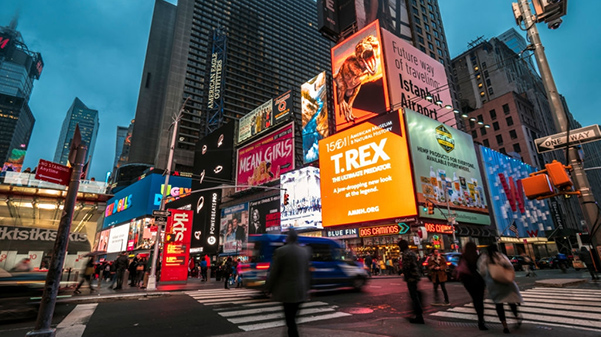We often hear the debate of which is better for marketing, billboards, or social media. The answer is that it depends on your specific campaign and what you are trying to achieve.
What is OOH or Out of Home Advertising?
These days, it seems as though most advertising and marketing are done digitally with a continuous stream of ads coming through to your social media pages, your television streaming platforms, your video game consoles, and everywhere in between. But the traditional form of OOH, or out-of-home advertising, remains one of the most effective forms of advertising for businesses small and large.
OOH has seen major growth in the last few years and will continue to expand due to the infusion of digital out-of-home advertising. What does DOOH mean? Digital out-of-home advertising encourages businesses to inject more creativity and boldness into their advertisements.
This guide will define OOH advertising, discuss exactly what OOH is, how it works, why it works, and how to start using it to your advantage today.
What is OOH or Out of Home Advertising?
Whether OOH is a term that you’ve started to hear pop up in casual conversation or you’ve never heard it before, you’ve experienced it. We all have.
So, what is OOH advertising?
Let’s start with answering “what does ooh mean?” Out-of-the-home.
Essentially, out-of-home advertising is any advertisement that you see when you are outside of your home. Any outdoor advertisement that doesn’t come directly to your phone, TV, tablet, or laptop is typically OOH advertising.
These are the advertisements that we encounter while we walk to the bus stop, drive to work, or wait for a flight at the airport. It can be anything as big as a billboard in the middle of Times Square or as small as a magnet that your local doggie daycare hands you as you walk by.
Any outdoor ad that we encounter when we’re out and about on any given day—that’s OOH.
These are some of the forms of OOH advertisements used today:
- Billboards such as:
- Bulletins
- Digital Billboards
- Posters
- Junior posters
- Wall Murals
- Street furniture including:
- Bus shelters
- Bus benches
- News racks
- Newsstands
- Phone kiosks
- Transit ads on the following:
- Airports
- Rails/subway
- Buses
- Taxis
- Rideshare
- Mobile trucks
- Places-based OOH like:
- Arenas/stadiums
- Cinemas
- Shopping malls
- Elevators
- Wild postings
- Complimentary merchandise
- Blimps
These are just a few of the common outdoor spots that businesses are using to optimize advertising, gain recognition, entice consumers, and accrue customers. Transit advertising is also an effective way to reach a wider audience compared to other traditional advertising methods.
Why is OOH Advertising Trending Now?
Surprisingly, such a steady and traditional form of advertising is currently having a sort of renaissance, so why is it happening and why now?
There are two main reasons for OOH Advertising’s current resurgence:
- Digital media advertising is becoming increasingly more difficult
- OOH is going digital—“DOOH Advertising”
The Difficulty of Digital Advertising
In the past, digital advertising was the go-to form of advertising for media buyers. It’s been an incredibly easy way to reach the consumer because a large majority of people spend a hefty chunk of their day looking at screens. Naturally, it makes sense to advertise where people tend to spend a lot of their time viewing or watching.
However, now that ad-blocking and ad-skipping have become increasingly more popular, it’s become harder and harder to reach the consumer.
The amount of ads that a person is exposed to online has exploded. Consumers are often annoyed by and become desensitized to ads—either choosing to block them, if that’s an option, or to ignore them.
The sheer amount of advertisements that a person sees on a given day makes it increasingly harder to make an individual brand or message stick out and grab the consumer’s attention.
Increase in DOOH Advertising
What is DOOH advertising?
DOOH or digital out-of-home advertising is the digitization of OOH. For example, as you pass by a local bus stop, you might notice that the ads by the bus’s timetables are no longer displayed on paper posters. Instead, a digital screen alternates between ads for a local restaurant, a real estate business, and an insurance company. It’s digital, yet out of the home—DOOH. Today, bus advertising is an effective way to reach new audience members. Not only does OOH marketing help boost brand awareness, but it also allows you to reach a wider target audience.
In the past, changing a billboard was a labor-intensive and clunky job. It took time and a lot of money to place a billboard and once it was up you were stuck with exactly what was there.
Now that digital out-of-home advertising has become easily accessible, the possibilities for advertising have exploded. Billboards can now be interactive and constantly changing. This allows for more tightly targeted messaging depending on the consumer base a business wants to attract.
DOOH or digital out-of-home advertising is on the rise now because of its many advantages including
- Cost-effectiveness
- Dynamic features that allow advertisers to change displays easily
- Ability to have multiple ads going at once
- Control over when the display is active, such as high traffic times
Why Media Buyers Love OOH Advertising
OOH advertising is a beloved tool for many media buyers. Among other benefits, OOH advertising is ubiquitous in a consumer’s day-to-day life, reaches a larger consumer base, has proven to convert viewers to buyers, and can amplify major media advertising.
If you’re interested in outdoor advertising in Fort Lauderdale, for example, there are endless opportunities to constantly expose your brand to those on foot or traveling in vehicles. Put simply, OOH advertising is unskippable and unblockable—you can’t turn it off, mute it, or fast-forward it—essentially making it unavoidable to consumers.
OOH Converts Viewers to Buyers
The main goal of marketing is to convert views of a product into purchases of that product. One of the key indicators to look at when analyzing marketing data is how many people who see an advertisement end up buying the product.
Nielsen conducted a study for digital billboards and digital street-level advertising(anything you see at eye level while you are walking around, i.e. a bus drives by with a movie poster on it) to check how many noticed the advertisements and then how many of those people who noticed the product then ended up buying the product.
According to the 2020 Nielsen Digital OOH Advertising Report, digital billboards had the following effects on consumer behaviours:
- 62% of survey responders noticed digital billboards in the past four weeks.
- When asked about how often consumers notice digital billboards, 50% of study participants said they were able to notice them most or all of the time.
- 65% of the study participants proceeded to engage with the content of the digital billboard after seeing it. Part of these engagement actions include searching for the promoter through a search engine, opening the promoter’s website, going to the store or restaurant, or viewing or posting on the advertiser’s social media profile.
The same study found that digital street-level OOH had the following impact:
- 49% of participants in the study said they noticed digital street-level OOH advertising within the previous 4 weeks.
- When asked how many times they noticed digital street-level ads, 52% of participants confirmed they were able to notice them most or all of the time.
- After noticing the street level digital ad, 69% of viewers engaged with the advertiser by visiting the brand’s website, visiting the brick-and-mortar location of the company, or exploring the brand’s social media presence.
The takeaway? The study shows that both digital billboards and digital street-level out-of-home advertising can be fruitful tools for engaging the consumer and getting them to interact with an advertised product.
OOH Amplifies All Major Media Advertising
Not only does OOH work on its own to attract consumers to a product but it is also proven to significantly boost the traction of a product’s digital media advertising.
1 OAAA. Digital Billboards Engage Consumers and Drive Action. https://oaaa.org/Portals/0/Digital%20Billboards%20Nielsen%20FINAL.pdf
According to a report commissioned by the Out of Home Advertising Association of America (OAAA) and conducted by MRI Simmons,
- When brands added OOH to digital video platform advertising, the report saw increases in brand significant exposure:
- Video Streaming (+132%)
- TV or movie smartphone/tablet apps (+226%)
- Downloading/streaming on cell or smartphone (+306%)
- Mobile video viewing (+340%)
The good news is you don’t have to choose between OOH and digital media advertising because they complement each other very well.
The majority of people walking around town have a mobile device on them, therefore, when they come across an OOH advertisement they are likely to look on their device to learn more about the item or product, which will lead them to your mobile media.
Optimizing OOH Advertising
Advertising is a necessary, yet increasingly more expensive endeavor—make sure you are thoughtful and strategic about where, when, and what you are placing to spend your advertising budget efficiently.
Here are a few key points to consider when optimizing your OOH:
- Location – Will it be seen? Is there a lot of foot traffic? Vehicle traffic?
- What is the goal? – Have a very clear goal for the piece and placement in mind. Is it meant to intrigue? Inform? Excite?
- Digital vs. Static – Yes, digital is where it’s at right now, but static still has a time and a place, make the decision that amplifies the goal you strive to achieve.
- Does it pop? – Consumers are constantly advertised to, what is going to make this specific OOH campaign stick out to them?
- Target audience –Who are you hoping will see this? If you want to target young professionals, placing a mural outside of a retirement home might not be the right move.
2 OAAA. OAAA Outlook Newsletter. https://oaaa.org/StayConnected/OAAAOutlookNewsletter/tabid/867/id/5883/Default.aspx
How True Impact Media Will Help Your Business Thrive
Now that we’ve answered “what is out of home advertising?” and covered DOOH advertising meanings, let’s talk about how to find it and use it to your advantage.
The searching and buying process for an OOH campaign has been somewhat tricky and time-consuming in the past. That’s why we at True Impact Media decided to improve the process by creating a universal OOH Media Buying Platform.
True Impact Media gives you the platform to:
- Track quotes from different vendors
- Find the best advertisement locations for your company
- Keep everything conveniently located in one place
- Pay no upfront fees or contracts
- Create RFP for free, see all of your OOH options, and plan dynamic campaigns
True Impact Media is efficient, flexible, and created to help you manage all parts of your OOH advertising campaigns from start to finish. Make your media buying process seamless and stress-free, start advertising today!
Sources:
OAAA. Out Of Home Advertising. https://oaaa.org/AboutOOH/OutofHomeAdvertising.aspx
OAAA. OAAA Outlook Newsletter.
https://oaaa.org/StayConnected/OAAAOutlookNewsletter/tabid/867/id/5883/Default.aspx
OAAA. Digital Billboards Engage Consumers and Drive Action.
https://oaaa.org/Portals/0/Digital%20Billboards%20Nielsen%20FINAL.pdf
OAAA. Digital Street Level OOH Engages Consumers and Drives Action.
https://oaaa.org/Portals/0/Digital%20Street%20Level%20Nielsen%20FINAL.pdf
Neil Patel. What is Out–Of–Home Advertising?
https://neilpatel.com/blog/out-of-home-advertising/
Broadsign. Everything You Need To Know About Out-Of-Home Advertising.



